This post explains the term: “bicycle frame geometry”. Frame geometry consists of important attributes like fork trail, rake, wheelbase etc. All those will be defined, explained, along with how they affect bicycle’s handling and ride characteristics. Separate posts explain bicycle frame comfort as well as how to set a comfortable bicycle riding position. Newer post explains the effective bicycle frame size: Bicycle frame “Stack” and “Reach” explained.
1. Bicycle frame
Frame is the spine and the heart of a bicycle. All other parts can easily be swapped, but the frame is what determines what combination of parts a bicycle can accept, what kind of use bicycle is best for and what seating positions can be achieved on a bicycle.
For example, frame choice determines what kind of brakes a bicycle can accept (disc, v-brake, or road bike brakes), what the maximum tyre width is, whether mudguards and racks can be mounted etc. This is easy to tell when choosing a frame – what kind of mounts it has. Also, producers mark these things in prospects (e.g. “disc brake frame” etc.).
Another thing that frame choice influences is seating position, comfort and bike handling. However, it is a lot less straight forward (than disc and mudguard mounts) and this post will explain how geometry influences ride and fitting characteristics. For an explanation of how frames are made to be strong, yet light, see the post: Bicycle frame design explained.
When it comes to bicycle frame geometry, good manufacturers usually provide a table with lengths and angles. For example:
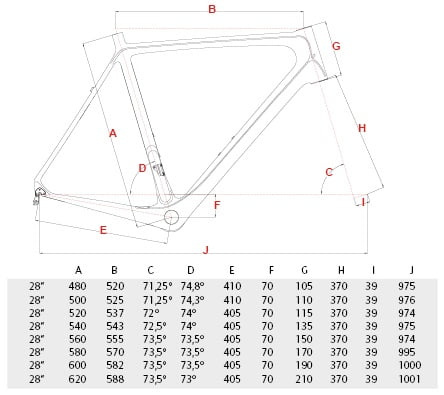
All the important dimensions and angles are noted.
As it is shown in the table above, geometry differs (more or less) for each frame size, even with the same model, of the same producer. Frame geometry is especially important if carrying loads on the front is planned (e.g. front panniers), since steering is usually calculated with expected front load in mind.
Text will give common values for a typical touring and a typical road bike frame. Both frames sized for an effective top tube length of 57 cm.
Effective top tube length is explained in this article: How to choose a correct frame size.
2. Steering – front part of the frame
Front part of the bicycle, along with the fork, has three important factors:
- Head tube angle
- Fork rake (it will be explained)
- Fork trail (also 🙂 )
2.1. Head tube angle
Angle is measured compared to the horizontal, with both wheels of planned size (usually the same size). In mechanics literature, this is called “rake”, while in cycling literature, “rake” is used for referring to fork offset (explained in chapter 2.2.).
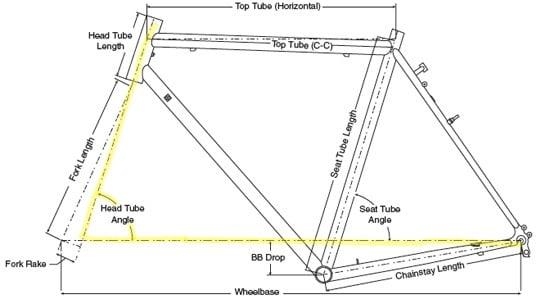
- The closer head tube angle is to vertical (90 degrees), the quicker the steering. However, if it is too vertical, bicycle will be twitchy, unstable.
- The sharper the angle, the more effort it takes to steer the bicycle. But slack head tube angle also improves stability.
Touring bikes that carry a lot of weight take advantage of more stable, 71 degree head tube angles. Road bikes that favour quick responsive steering and are not loaded usually settle for 73 degrees.
Suspension fork downhill bikes usually have a small head tube angle of about 65 degrees (“slacker” geometry) – for a better bump-attack angle, and stability.
2.2. Fork rake (offset)
Distance for which the front wheel dropout is moved forward from the head tube axis. Forks are usually angled forward a bit, or have a curve to the front near the bottom. In mechanics literature, this is called “fork offset”, while “rake” is used to refer to what is called “head tube angle” in cycling literature – there are many such misnomers in cycling literature and jargon.
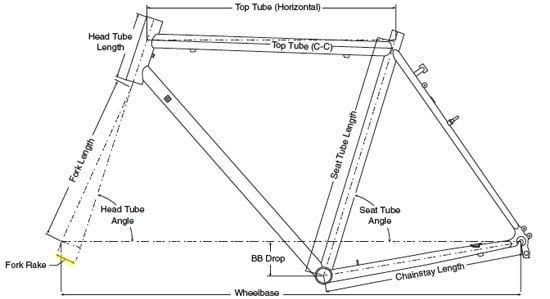
Distance of the front wheel dropout from an (imaginary) axis going from the middle of the head tube.
- Increasing the rake makes steering faster
- Decreasing it makes steering slower
Rake influences distance of the front wheel from the pedals and wheelbase length. It also affects steering but by increasing/decreasing trail, not directly, which will be explained.
Touring bikes often have a lot of rake, in order to increase wheelbase as well as to avoid toe overlap.
Typical values are 45 mm for touring and 40 mm for road bicycles.
Modern suspension mountain bike forks often have rake values between 40–51 mm. A ~ 50 mm rake is appropriate for cross-country and trail bikes, especially to balance stability and agility. Downhill bikes, on the other hand, have a sharper head tube angle, resulting in a smaller, ~45 mm rake.
Still, since rake is in conjunction with trail (and head tube angle), touring bikes end up having slower steering compared to road bikes, in spite of having more rake. Explanation follows now:
2.3. Fork trail
Fork trail is a result of head tube angle, fork rake and front wheel diameter. Front wheel diameter increase, also increases trail, while other two factors have reverse influence, e.g. bigger rake results in smaller trail.
Trail length lets us know how quickly a bike steers. The other factors mostly just influence steering through affecting trail – indirectly.
- Less trail results in faster steering
- More trail results in slower steering
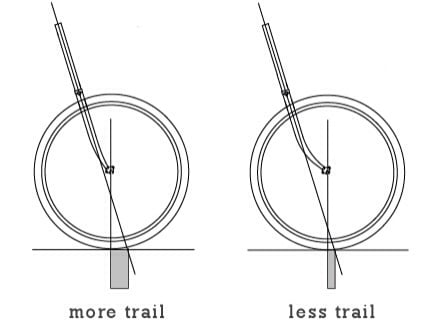
The fork on the left has less bend, that is smaller rake.
This results in left bike having more trail (and slower steering).
Touring bicycles have more trail, in order to slow the steering and make heavily loaded bicycle more stable on a fast descend for example. The problem with having more (or too much) trail is difficulty to keep a straight line when riding at slow speed. Also, it can cause bike to steer from side to side when pedalling while standing. Heavy front load on touring bikes often compensates for this.
Typical trail values are around 65 mm for touring and 55 mm for road bikes.
2.4. Steering recapitulation
Slacker head angle and more trail results in slower steering. Practical for carrying loads on a bike, while not very convenient for a light bicycle.
Less trail with a steeper head angle results in quicker steering. Good for light racing bicycle, inconvenient for carrying load.
Somewhere in between those extremes falls the steerer geometry of most cyclocross and hybrid bicycles.
In the article about bicycle forks I also briefly discussed how fork length affects steering and frame geometry.
3. Chainstay length
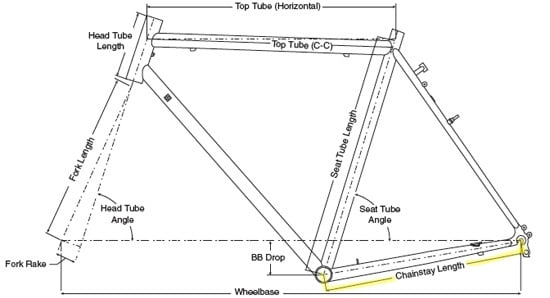
Chainstay length influences 3 things:
- Steering – longer chainstay increases wheelbase length and makes a bicycle more stable, but also makes steering (and maneuvering) slower.
- Comfort – longer chainstay also increases comfort (detailed explanation of bicycle frame comfort). Short chainstay gives an effect of sitting directly on top of the rear wheel, while a long one makes rider sit half way between two wheels, making the ride more comfortable.
- Luggage carrying capacity – with a longer chainstay, panniers mounted on the rear rack will be further from the pedals. Very important for big footed riders.
Typical values are 46 cm for touring and 41 cm for road bikes.
4. Wheelbase
Longer wheelbase makes bike more stable, more comfortable, but makes steering slower.
Touring bikes have slack head angle, long fork rake, and long chainstay which gives them long wheelbase. Road bikes have it all the opposite way. 🙂
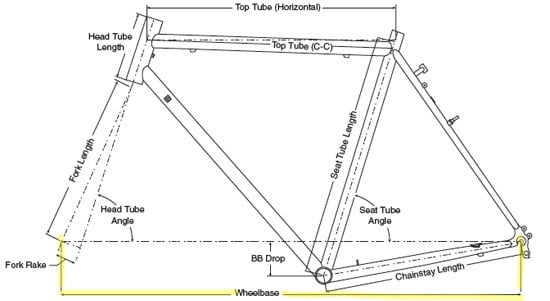
The influence of wheelbase on steering is almost as big as the fork trail and angle.
Typical values are 1060 mm for touring bikes and 995 for road bikes
5. Bottom bracket drop (BB drop)
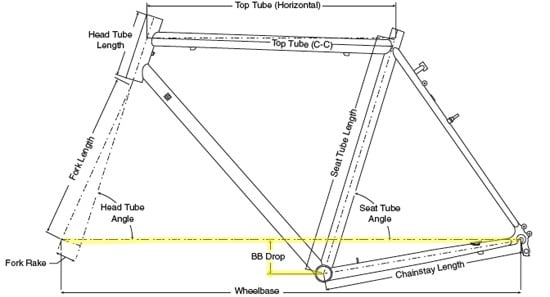
(relative to the wheels axes)
Because saddle height is set relative to the pedals, lower bottom bracket results in the saddle being placed lower (for the same rider height), which results in a lower centre of gravity.
Lower centre of gravity is always good – it gives better stability and maneuverability. However, since bicycle is leaned into turns, this matters a lot less than for cars.
What does matter is ground clearance. Frames built for off road riding often have lower BB drop (hence a higher bottom bracket) to prevent it from catching bumps and rocks. Also, when pedalling in a turn, a bicycle is less likely to strike the ground with a pedal if the BB is higher.
For city riding, lower BB enables the rider to put a foot down wile seated and waiting at a traffic light.
All other things being equal (wheelbase, tube material and thickness), a smaller BB drop (therefore higher BB) makes shorter chainstay, shorter seat tube and down tube. This results in a lighter and stiffer frame.
Values differ, depending on the frame purpose, but some middle, often used value is around 7 cm.
6. Seat tube angle
This depends mostly on frame size, since optimal pedalling position does not change that much between bikes.
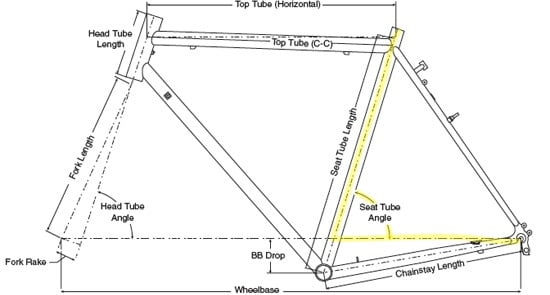
– Measured from horizontal line
For frames “sized” 57 cm, usual angle is around 73 degrees.
7. Seat tube length
Often stated as frame “size”. One of the least important factors in frame geometry. Value is important only to shorter riders to know whether they can stand over the frame.
8. Head tube length
If a frame is meant for a more upright riding position, head tube is longer. Touring bikes often have around 20 cm, while road bikes go around 15 cm. Head tube length changes with frame size.
My video explainig and showing the basics differences in road, and trekking bicycle frame geometry, along with the basics of fitting (i.e. setting up a comfortable riding position):
Last updated:
Originally published:

Head tube length impacts the stiffnes (accuracy/ precision) of the steering. Top tube and down tube hold head tube like two branches and they form angle: obtuse one or acute one. It’s the same principle with lateral stiffnes of wheels and angle where spokes come in/out. Supsension forks make it difficult, because You need to have room for front fork squeezing to the bottom of the stroke. Industry tries to run away buy using larger bearings in headtube but is only partial solution.
The most extreme head tube lenght is seen in Pedersen bicycles:
https://upload.wikimedia.org/wikipedia/commons/2/2e/Dursley_Pedersen_ca_1910_bicycle.jpg
Some motorcycles also use little tricks to extend effective head tube lenght, for example Tele-lever suspension:
[
Relja’s edit – fixed broken link:
https://www.bmwmotorcycles.com/en/engineering/detail/suspension/telelever.html
]
I ride old-school bicycle (not Pedersen though) with long head tube and it steers very precisely.
Great and informative comment. 🙂
Correct me if I’m wrong – Pedersen frame design is built with the aim of avoiding (minimizing) any torsion on the frame tubes, having them take all the forces by compression?
I gave myself the liberty to add a link that shows the concept (if we are thinking of the same concept for Tele-lever suspension), the original one posted didn’t work (“Error 403 – forbidden”).
The motorcycle concept seems to (also) be about having the optimal compression and rebound damping configuration while riding on the road, while still being able to soak up harsher bumps when going off road. If I understood the concept correctly – didn’t know that existed until now! 🙂
Dear friend,
I would like to know the artistic cycling bike frame dimension with its picture.
I couldn’t find it on web pages.
I would thank you if you help me and provide upon my request.
Thank you.
Bert informative and useful article, Thanks a lot.
One passage I couldn’t understand.
“ The problem with having more (or too much) trail is difficulty to keep a straight line when riding at slow speed. Also, it can cause bike to steer from side to side when pedalling while standing.”
If a longer trail generally makes the bike more stable / less twitchy, why would it make it less stable (I. e. harder to keep a straight line) at slower speeds and while pedaling out of saddle?
Thanks.
Hi Dorin,
That’s a good question – I’ll try to explain.
At high speed, when riding seated (in the saddle), more trail increases stability.
At lower speeds, especially when riding out of the saddle, it decreases it.
For example, when riding standing, pedalling hard and tilting the bike from left to right, the rider inadvertently causes (small) steering inputs – since the handlebars are used for leverage (i.e. pulled against) in order to press hard on the pedals. More trail amplifies this input.
A bit more info:
The head tube angle is designed to have the average impact of significantly sized bumps go straight to the steerer – loading it axially.
For road bikes, used on paved roads with smaller bumps, the angle is usually set to 73 degrees from horizontal. For off-road bikes, it is usually a bit less vertical (so to say), with about 71 degrees from horizontal – as those bikes see bigger bumps on average.
Then, with a given head angle, fork legs are curved (or placed at a greater angle right as they exit the fork crown section) in order to reduce the trail which would be huge if the fork legs were just straight, following the head tube angle.
Digression:
Sometimes, like on my motorcycle, this is achieved by using a triangle mount, with fork legs being mounted in front of the steering axis – while still being fully straight in order to allow the suspension to work, and provide a rigid structure. Some downhill bikes use a similar mounting system, but they reduce the trail solely in the bottom section, by moving the wheel mounting point a bit towards the front, while the fork legs are inline with the steering bearings, not in front of them.
Either way, the idea is to get an optimal amount of trail for the bike’s intended use.
For a bit more info about bicycle steering (even though it doesn’t directly address this particular question), you can see my article called “Countersteering – bicycle steering.”
With that effect in mind (the countersteering), one can view the trail as a self-stabilizing steering factor – when there is no rider input, longer trail helps the bike self-stabilize faster. Bike steering in general is a rather complicated, counterintuitive phenomena, and I for one have not come up with a formula that lets me say “for this mass distribution, frame size, fork angle, bike use etc – this amount of trail is optimal.” It is also my impression that in the bicycle industry as well, it is a similar situation – and a lot of the design boils down to trial and error (or just to copy/paste of what’s worked over the past 100 years).
“ the rider inadvertently causes (small) steering inputs – since the handlebars are used for leverage (i.e. pulled against) in order to press hard on the pedals. More trail amplifies this input.”
You mean the kind of input that the rider does not want and that is actually a side effect of pulling hard on the handlebars? Or… the corrections the rider is making to compensate for the side to side wagging when going hard out of saddle?
The kind of “unwanted” (accidental but unavoidable) input.